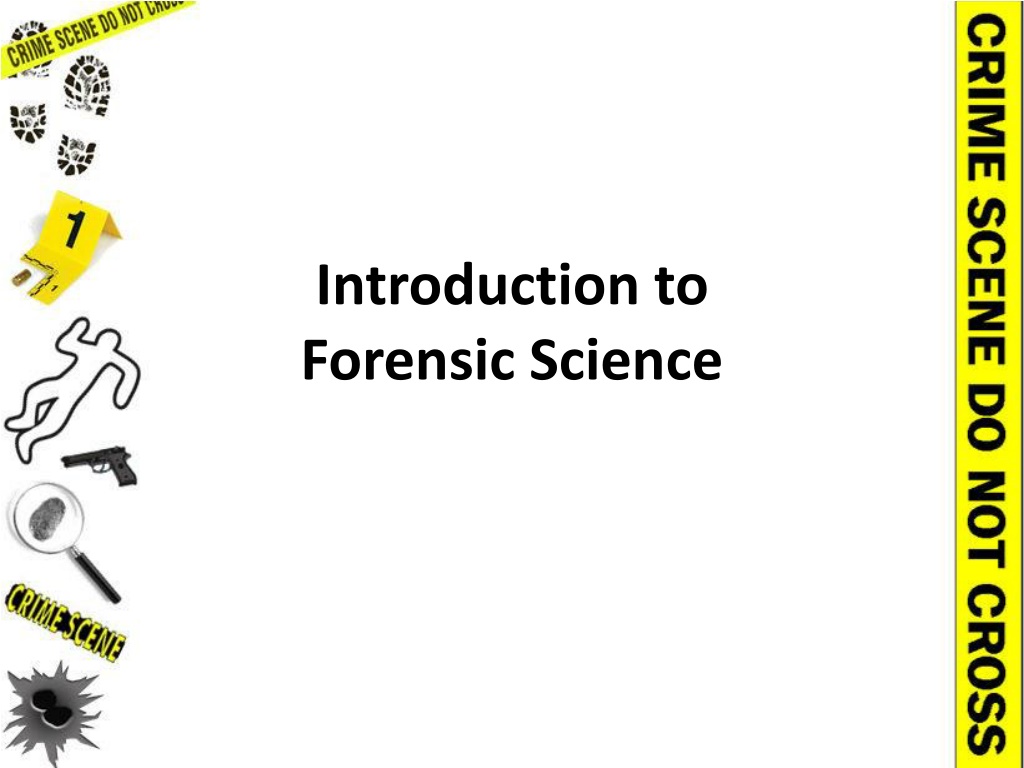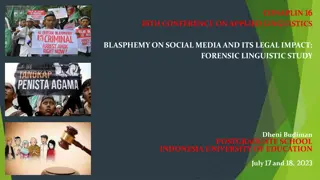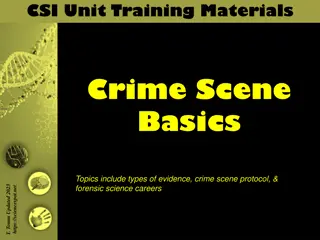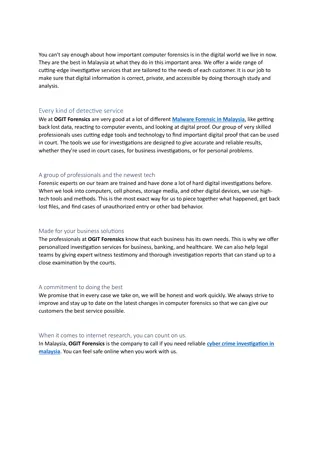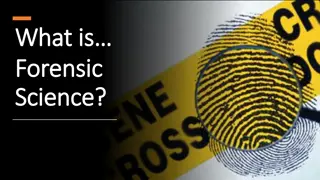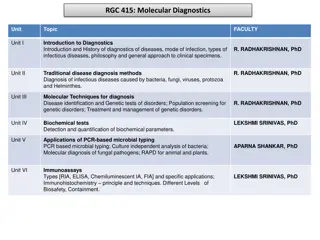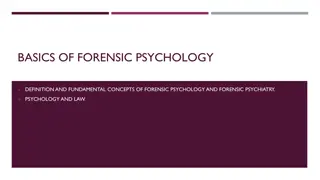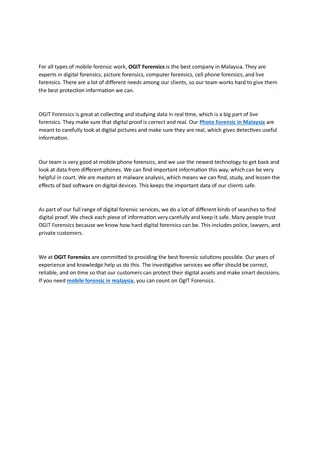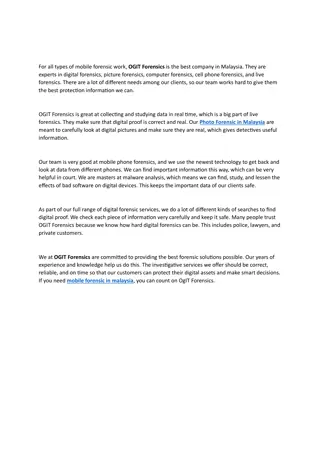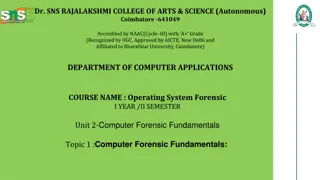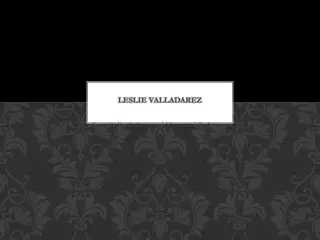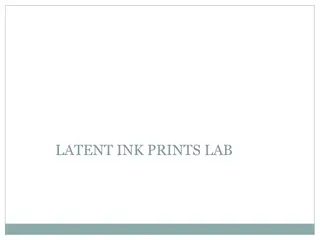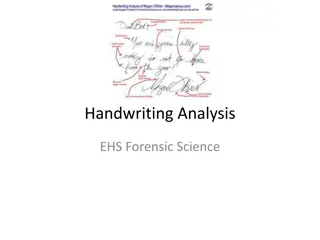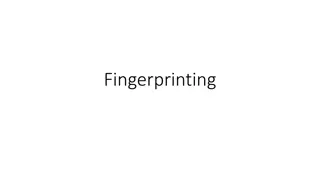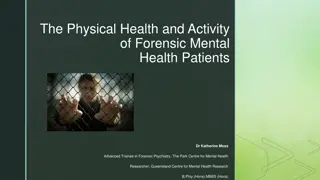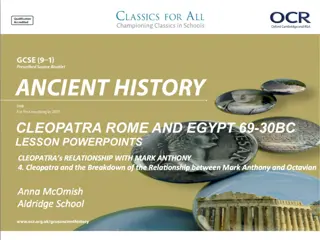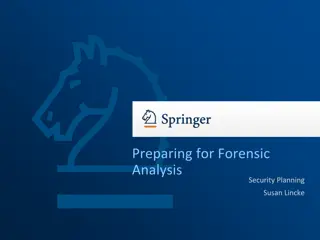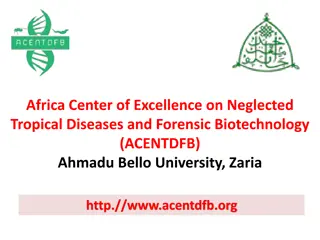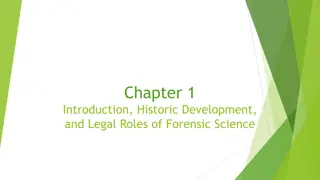Understanding the Impact of Forensic Science: A Case Study of Casey Anthony
Explore the intriguing case of Casey Anthony, highlighting the application of forensic science in criminal investigations. Delve into the complexities of the trial, from evidence analysis to the challenges faced by expert witnesses in presenting compelling testimony.
Download Presentation

Please find below an Image/Link to download the presentation.
The content on the website is provided AS IS for your information and personal use only. It may not be sold, licensed, or shared on other websites without obtaining consent from the author. Download presentation by click this link. If you encounter any issues during the download, it is possible that the publisher has removed the file from their server.
E N D
Presentation Transcript
Introduction to Forensic Science
Introduction to Forensic Science: Learning Objectives Define forensic science Explain the development of forensic science throughout history Describe the services of a typical comprehensive crime laboratory in the criminal justice system Explain the role and responsibilities of the expert witness
Introduction to Forensic Science: Vocabulary Expert Witness Locard s Exchange Principle Scientific Method
CASEY ANTHONY: THE CSI EFFECT? CASEY ANTHONY: THE CSI EFFECT? July 15, 2008 Cindy Anthony makes a 911 call reporting that her granddaughter Caylee is missing Caylee has not been seen in 31 days When she asked her daughter, Casey, gives a variation of explanations as to Caylee s whereabouts Finally, Casey confesses to Cindy she has not seen Caylee in weeks
CASEY ANTHONY: THE CSI EFFECT? CASEY ANTHONY: THE CSI EFFECT? State and nation-wide search for Caylee Anthony begins as Casey tells authorities that Caylee was kidnapped by a nanny on June 9 December 11, 2008 Caylee s remains are found in a blanket inside of a trash bag in a wooded area near the family home
CASEY ANTHONY: THE CSI EFFECT? CASEY ANTHONY: THE CSI EFFECT? The state s theory was that Casey used chloroform to render Caylee unconscious Placed duct tape over Caylee s mouth and nose Kept her remains in the trunk of her car for several days before disposing it Casey is charged with first-degree murder in October 2008
CASEY ANTHONY: THE CSI EFFECT? CASEY ANTHONY: THE CSI EFFECT? Trial lasts from May to July 2011 Casey is charged with first-degree murder The closest the state comes to a direct link was a hair found in the trunk of Casey s car DNA test could only link the hair to Caylee s maternal relatives No unique characteristics were found to link the duct tape on the body with that found in the Anthony home
CASEY ANTHONY: THE CSI EFFECT? CASEY ANTHONY: THE CSI EFFECT? No DNA, No fingerprints, No conviction July 5, 2011 Jury finds Casey Anthony not guilty or first-degree murder, aggravated child abuse, and aggravated manslaughter of a child https://www.youtube.com/watch?v=RHcwD39Zgkg
Definition and Scope Application of science to the criminal and civil laws that are enforced by police agencies in a criminal justice system Criminalistics and forensic science are the same field criminalistics is more descriptive than forensic science
Criminal Law vs Civil Law Designed to prevent citizens from harming each other Involves actions that have been declared illegal Always filed by the government called the prosecution Deals with disagreements between private individuals One person claims the other person s actions caused him harm The party filing the lawsuit is called the plantiff
Definition and Scope While shows like CSI have increased public awareness, they give an unrealistic view of how the process works CSI effect the dramatization of forensic science has led people to believe that every crime scene will yield forensic evidence and procedures unrealistic expectations https://www.youtube.com/watch?v=fGc4PaLB-ek
Development of Forensics 3rd Century China one of the earliest recordings of forensic science 1686 first notes about fingerprints Late 1800s public officials begin to apply science to the study of crime 1893 first treatise describing the application of scientific disciplines to criminal investigation
Late 19th Century Progress Best known figure in the late 19th century forensics was Sherlock Holmes https://www.youtube.com/watch?v=8I9pxUdZbuQ
20th Century Breakthroughs 1901 discovery of different blood types 1910 pioneering work in document examination LOCARD S EXCHANGE PRINCIPLE When two objects come into contact with one another, there is exchange of materials between them
Crime Laboratories 1923 first forensic lab opened as part of the Los Angeles Police Department 1932 FBI organized a national lab that offered forensic services to all law enforcement agencies in the country FBI Laboratory is now the world s largest forensic lab
Services of the Crime Lab Physical Science Unit Applies chemistry, physics, etc. to crime scene evidence; Experts in chemical testing; Drug ID, Soil/Mineral analysis, Trace Evidence Biology Unit Biologists and Biochemists; DNA profiling on bloodstains and bodily fluids, hairs & fibers Firearms Unit Examines firearms, discharged bullets, cartridge cases, shotgun shells, and ammo
Services of the Crime Lab Document Examination Unit Studies handwriting and typewriting on questioned documents; analyzing paper and ink Photography Unit Examines and records physical evidence; may require highly specialized photographic techniques, such as digital imaging, infrared, UV, and X-ray
Optional Services Toxicology Unit Latent Fingerprint Unit Polygraph Unit Voiceprint Analysis Unit Crime-scene Investigation Unit
Functions of the Forensic Scientist Analyze physical evidence AND provide expert testimony Analyzing Physical Evidence Physical evidence is unbiased and must undergo scientific inquiry The scientific method is a process that uses strict guidelines to ensure careful and systematic collection, organization, and analysis of information
Analyzing Physical Evidence When a hypothesis is validated, it can be used in a court of law Admissibility of Evidence Frye v. US (1923) set the Frye Standard expert opinion based on scientific technique is admissible only where the technique is generally accepted as reliable in the scientific community The Federal Rules of Evidence (1973) offers more flexible standard for admitting scientific evidence Assigns the trial judge the task of ensuring that an expert s testimony rests on a reliable foundation and is relevant to the case
Providing Expert Testimony Forensic scientists are often called to testify about their methods or conclusions An expert witness is an individual whom the court determines to possess knowledge relevant to the trial that is not expected of the average person Must be able to explain their methods and conclusions to non-scientists The expert must stick to the evidence no matter what direction it may lead
Training in the Proper Recognition, Collection, and Preservation of Physical Evidence If proper recognition, collection, and preservation of evidence does not occur, it doesn t matter how fancy the lab is or how qualified the forensic scientist is Forensic scientists participate in training law enforcement personnel in the proper recognition, collection, and preservation of physical evidence
